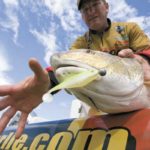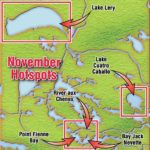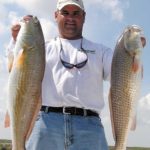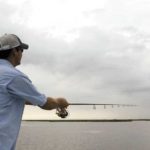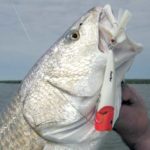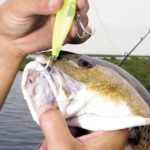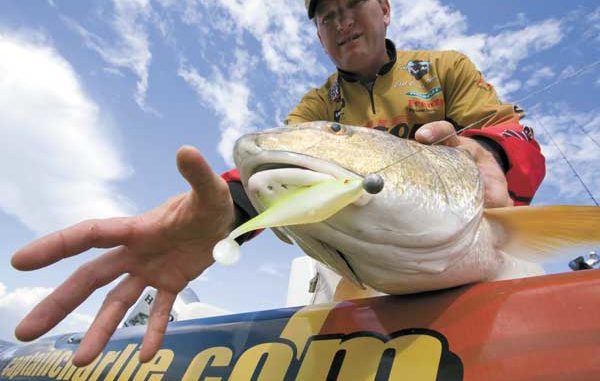
The storms that stripped the grass out of the Delacroix and Hopedale marshes will actually make catching reds easier this fall.
Some see the loss of jobs to foreign countries as an opportunity to complain about how all our jobs are going overseas. Some see the loss of jobs to foreign countries as an opportunity to retrain themselves for a better job.
It’s easy to sit around and complain because things aren’t the same as they used to be. But how many of us are hitting the streets looking for jobs as telegraph operators, blacksmiths or cobblers? Come to think of it, I haven’t seen too many leech doctors around anymore either.
Isn’t it more productive to put our energies into figuring out how to become a more-skilled worker — or in the case of Hopedale this November, a more-skilled angler?
If you haven’t been to Hopedale or Delacroix since the summer, you are going to find a very different landscape than what you remember. In other words, things have changed since Hurricanes Gustav and Ike. The question is are you going to complain about the lack of grass, or are you going to figure out where the redfish are and catch them?
Just a couple months ago, I stood on the deck of Capt. Joe Vinson’s Triton bay boat, and cast She Dogs and MirrOmullets to the edges of the lush, green grass mats. Some of the bays were so full of grass that the reds were waking over it out in the middle of the open water rather than down the shoreline. Catching redfish and the occasional bass or two was no problem.
“It’s all gone,” Vinson told me after the storm. “The storm surge from Gustav wiped it all out. Some people might get distracted at the lack of grass when they fish over here, but in my opinion, I think it’s actually going to make the redfishing this November even better than what it would have already been.”
The main reason is that the fish will have very few areas in which they can hide. Because they can’t get way back in the grass, where they’re hard to get to, the reds should be positioned in open areas where everybody can reach them.
Vinson, who guides for Bayou Charters, got an early taste of what this month could be like under the given conditions. While fishing a point with shrimp under a cork, he couldn’t keep the reds off his hook.
“We were fishing in Four Horse, and we caught 81 reds,” said Vinson at the beginning of October. “Then another one of our guides went back the next day and landed 71. That’s the way it gets over here during the fall, though. You can catch 100 redfish a day during November with no problem.”
Vinson’s favorite November redfish pattern, running the pockets on the corners of main points, could be even better this year with so many redfish looking for places to congregate due to the lack of grass. Rather than a few fish stacked up around the pockets, there could be 20 or 30.
“I like the points that are what I would consider broken,” said Vinson. “These are the ones that if you looked at them on a map, the edges of the point would be very bumpy looking. These pockets also have two points at their openings, so I guess you could say a good pattern for this November would be fishing the smaller points that lead into the pockets on the edges of the larger main points.”
Some good areas to look for this kind of situation are Pointe Fienne, Four Horse Lake and Lake Lery. These are the areas that typically hold big schools of redfish during the fall, and Vinson believes the schools will be bigger with the lack of grass.
When the water temperature starts falling, anglers will typically see large schools of cruising reds rather than an isolated fish here and there. Vinson says these big schools of fish will generally travel the shoreline rather than cruise the open bays, and the best situation is for one off these big schools to find the secondary points on the sides of the main points.
“Those smaller points should stack them up pretty good,” he said. “As they’re cruising up and down the side of a point and they see all the bait congregated in those pockets, they’ll stack up there and eat until it’s gone or they’re full. They may move on you a little bit from day to day, but they shouldn’t be very far away from where you first find them.”
During the fall months, Vinson’s preference is just that the tide move rather than that it move a particular direction. Much like the summer months, the important thing is that there is some kind of water movement. In Vinson’s opinion, anything in the 0.7- to 1.2-range would be good enough to get the water moving well enough without it being a smoking-fast tide.
“When I’m looking for redfish in this situation, I like to jump from point to point, and I give each spot about five minutes,” said Vinson. “These points are close enough that you don’t have to run very far between them, and sometimes all you have to do is get on your trolling motor.”
To quickly find groups of redfish, Vinson relies heavily on a chartreuse diamond 4-inch Saltwater Assassin Curly Tail Shad fished under a popping cork. Being that the water from Hopedale to Delacroix tends to be root beer-colored this time of year, Vinson feels this particular color does a good job of standing out without being too bright.
Vinson also can’t help but give his favorite bone or black/chartreuse She Dog a try every now and then. He says his best topwater bite during the fall is typically on calm, clear mornings. As for the She Dog, Vinson’s feeling is that it sounds more like a shrimp popping on the water’s surface than some of the others.
Like anglers all across the state this month, those fishing Hopedale should pay attention to the timing of the cold fronts that roll through Southeast Louisiana. However, unlike the trout fishing, the redfish bite might just get even better after a front blows through.
“They tend to keep on doing what they were doing before a front blows through,” said Vinson. “If anything, it might even group them up more, which means there are going to be more fish concentrated in the same point areas.
“The good thing is that the wind doesn’t really beat you up very bad because most of this fall fishing is back in the lagoons and ponds where you can usually find some points that are in protected areas.”
Like the Louisianans that chase them, redfish excel at adjusting to life after the storm. They will adjust very well to the lack of grass from Hopedale to Delacroix, as they will simply change what kind of structure to gang up around.
Assuming you adjust as well, there shouldn’t be any misunderstanding why Vinson and other Hopedale regulars have dubbed this month as Red November. Perhaps the more things change, the more they really stay the same.
Contact Bayou Charters at 504-278-FISH or at www.captaincharlie.com.
